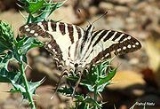
Graphium nomius
Encyclopedia
Spot Swordtail Graphium nomius is a beautiful butterfly
found in South
and Southeast Asia
that belongs to the Swallowtail
family. One of the grandest sights is a host of Spot Swordtails mud-puddling or swarming around a flowering forest tree.
The Spot Swordtail gets its name from the beautiful line of distinct white spots along the margin of its wings.
and Assam
), Sri Lanka
, Nepal
, Bangladesh
, Myanmar
, Thailand
, Vietnam
, Laos
and Kampuchea.
chiefly in the greater width of the black markings on the upperside, especially of the basal and subbasal bands that cross the fore wing, both of which also extend to the dorsum. On the hindwing the black markings of the underside on the basal and discal areas are not only seen by transparency from below, but are actually represented, though only partially, by black scaling; the width of the dark grey terminal portion is also greater, and it has a tendency to turn to dusky black anteriorly, so that the sub-terminal series of black lunules are obscured anteriorly and are difficult to make out. Underside: markings similar to those of the typical form, but broader; fore wing with the discal transverse band that reaches from costa to vein 1; hind wing: the black bands that cross the cell broader and proportionately closer together.
Has a 94-100 mm expanse.
_w_img_9180.jpg) Males and females. Upperside bluish-white. Fore wing: cell with five broad transverse black bands, the basal and subbasal bands produced to the dorsum, the medial band generally extended into interspace 2, the preapical ended on the median rein, and the fifth or apical from costa along the discocellulars extends on both sides of these and terminates at lower apex of cell; beyond the fifth band is a short macular transverse bar of the ground-colour that terminates on vein 5, followed by a very broad black terminal band that occupies about one-third of the width of the wing and is traversed by a transverse subterminal series of rounded spots of the ground-colour. Hind wing: ground-colour along dorsum and above vein 7 whitish; a streak along the dorsum, a subbasal and an inner discal transverse band from costa across cell, and a very broad terminal band, black; the former two joined near the tornus by cross lunular black marks, the terminal band traversed by a series of slender lunules of the groundcolour ; a small black spot in interspace 1 above tornus and another at base of interspace 4; the black at the apices of interspaces 2 to 4 and the lunules of the ground-colour thereon suffused with grey; tail black, edged and tipped with white.
Males and females. Upperside bluish-white. Fore wing: cell with five broad transverse black bands, the basal and subbasal bands produced to the dorsum, the medial band generally extended into interspace 2, the preapical ended on the median rein, and the fifth or apical from costa along the discocellulars extends on both sides of these and terminates at lower apex of cell; beyond the fifth band is a short macular transverse bar of the ground-colour that terminates on vein 5, followed by a very broad black terminal band that occupies about one-third of the width of the wing and is traversed by a transverse subterminal series of rounded spots of the ground-colour. Hind wing: ground-colour along dorsum and above vein 7 whitish; a streak along the dorsum, a subbasal and an inner discal transverse band from costa across cell, and a very broad terminal band, black; the former two joined near the tornus by cross lunular black marks, the terminal band traversed by a series of slender lunules of the groundcolour ; a small black spot in interspace 1 above tornus and another at base of interspace 4; the black at the apices of interspaces 2 to 4 and the lunules of the ground-colour thereon suffused with grey; tail black, edged and tipped with white.
_at_23_mile,_duars,_wb_w_img_5883.jpg) Underside white, the black markings very similar but of a bronze-brown with the following exceptions:—Fore wing: extensions below the median vein of the basal, subbasal, and median transverse bands crossing the cell, and the inner portion below vein 4 of the terminal broad band, black: on the hind wing the inner discal band is broken, irregular and black, and is bordered by a series of red spots outwardly edged with black ; the subterminal series of lunules of the ground-colour are broadly edged on the outer side with black; the grey patch in the caudal region is replaced by ochraceous grey. Antennae black; head, thorax and abdomen creamy white, with a medial broad longitudinal stripe; beneath, the abdomen with lateral black stripes.
Underside white, the black markings very similar but of a bronze-brown with the following exceptions:—Fore wing: extensions below the median vein of the basal, subbasal, and median transverse bands crossing the cell, and the inner portion below vein 4 of the terminal broad band, black: on the hind wing the inner discal band is broken, irregular and black, and is bordered by a series of red spots outwardly edged with black ; the subterminal series of lunules of the ground-colour are broadly edged on the outer side with black; the grey patch in the caudal region is replaced by ochraceous grey. Antennae black; head, thorax and abdomen creamy white, with a medial broad longitudinal stripe; beneath, the abdomen with lateral black stripes.
Wing expanse of 68-95 mm.
forest areas, among bushes with lesser secondary growth. Locally abundant below 3000 feet and less common above this level. Generally stays close to hilly and forested country.
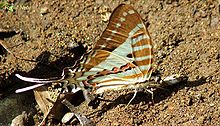 Shy and wary. Flies close to the ground . Has a dodgy and fast flight, especially when disturbed.
Shy and wary. Flies close to the ground . Has a dodgy and fast flight, especially when disturbed.
Often visits flowers. Spot Swordtails may be seen to cluster around flowering trees. They are fond of Gmelina arborea
, a deciduous
tree from dry areas. Large numbers can be seen settling on damp roads and wet patches, especially in hot summers.
Basks close to the ground, with wings partially open or completely spread.
Known migrant in Sri Lanka.
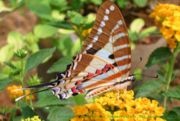
it has been recorded from February to October.
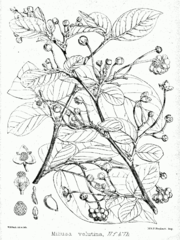 Eggs
Eggs
are spherical, yellowish and slightly shiny. They are laid singly on the upper surface or at the margin on the under-side of young leaves or buds.
"Not so thick proportionally at the fourth segment as those of agamemnon, sarpedon and doson, and is somewhat quadrangular. It has four pairs of spines which are small but sharp. The most usual colour......is black, banded on the sides with narrow white stripes, except on the first three or four segments and the last., on which there is more or less rusty red ; but the shade varies very much, and in some the groundcolour is green." (Davidson and Aitken
)
of the Family Anonaceae. Miliusa tomentosum is a deciduous tree. The pupae of the previous year's brood
emerge, seek mates and lay eggs just as the tree puts out new growth.
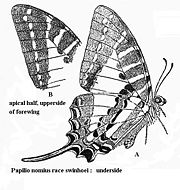
Butterfly
A butterfly is a mainly day-flying insect of the order Lepidoptera, which includes the butterflies and moths. Like other holometabolous insects, the butterfly's life cycle consists of four parts: egg, larva, pupa and adult. Most species are diurnal. Butterflies have large, often brightly coloured...
found in South
South Asia
South Asia, also known as Southern Asia, is the southern region of the Asian continent, which comprises the sub-Himalayan countries and, for some authorities , also includes the adjoining countries to the west and the east...
and Southeast Asia
Southeast Asia
Southeast Asia, South-East Asia, South East Asia or Southeastern Asia is a subregion of Asia, consisting of the countries that are geographically south of China, east of India, west of New Guinea and north of Australia. The region lies on the intersection of geological plates, with heavy seismic...
that belongs to the Swallowtail
Swallowtail butterfly
Swallowtail butterflies are large, colorful butterflies that form the family Papilionidae. There are over 550 species, and though the majority are tropical, members of the family are found on all continents except Antarctica...
family. One of the grandest sights is a host of Spot Swordtails mud-puddling or swarming around a flowering forest tree.
The Spot Swordtail gets its name from the beautiful line of distinct white spots along the margin of its wings.
Range
Southern and Eastern India (including SikkimSikkim
Sikkim is a landlocked Indian state nestled in the Himalayan mountains...
and Assam
Assam
Assam , also, rarely, Assam Valley and formerly the Assam Province , is a northeastern state of India and is one of the most culturally and geographically distinct regions of the country...
), Sri Lanka
Sri Lanka
Sri Lanka, officially the Democratic Socialist Republic of Sri Lanka is a country off the southern coast of the Indian subcontinent. Known until 1972 as Ceylon , Sri Lanka is an island surrounded by the Indian Ocean, the Gulf of Mannar and the Palk Strait, and lies in the vicinity of India and the...
, Nepal
Nepal
Nepal , officially the Federal Democratic Republic of Nepal, is a landlocked sovereign state located in South Asia. It is located in the Himalayas and bordered to the north by the People's Republic of China, and to the south, east, and west by the Republic of India...
, Bangladesh
Bangladesh
Bangladesh , officially the People's Republic of Bangladesh is a sovereign state located in South Asia. It is bordered by India on all sides except for a small border with Burma to the far southeast and by the Bay of Bengal to the south...
, Myanmar
Myanmar
Burma , officially the Republic of the Union of Myanmar , is a country in Southeast Asia. Burma is bordered by China on the northeast, Laos on the east, Thailand on the southeast, Bangladesh on the west, India on the northwest, the Bay of Bengal to the southwest, and the Andaman Sea on the south....
, Thailand
Thailand
Thailand , officially the Kingdom of Thailand , formerly known as Siam , is a country located at the centre of the Indochina peninsula and Southeast Asia. It is bordered to the north by Burma and Laos, to the east by Laos and Cambodia, to the south by the Gulf of Thailand and Malaysia, and to the...
, Vietnam
Vietnam
Vietnam – sometimes spelled Viet Nam , officially the Socialist Republic of Vietnam – is the easternmost country on the Indochina Peninsula in Southeast Asia. It is bordered by China to the north, Laos to the northwest, Cambodia to the southwest, and the South China Sea –...
, Laos
Laos
Laos Lao: ສາທາລະນະລັດ ປະຊາທິປະໄຕ ປະຊາຊົນລາວ Sathalanalat Paxathipatai Paxaxon Lao, officially the Lao People's Democratic Republic, is a landlocked country in Southeast Asia, bordered by Burma and China to the northwest, Vietnam to the east, Cambodia to the south and Thailand to the west...
and Kampuchea.
Description
Differs from the typical form Graphium antiphatesGraphium antiphates
Five-bar Swordtail Graphium antiphates is a species of papilionid butterfly found in South Asia.-Description:The ground colour of the upperside of both males and females is white...
chiefly in the greater width of the black markings on the upperside, especially of the basal and subbasal bands that cross the fore wing, both of which also extend to the dorsum. On the hindwing the black markings of the underside on the basal and discal areas are not only seen by transparency from below, but are actually represented, though only partially, by black scaling; the width of the dark grey terminal portion is also greater, and it has a tendency to turn to dusky black anteriorly, so that the sub-terminal series of black lunules are obscured anteriorly and are difficult to make out. Underside: markings similar to those of the typical form, but broader; fore wing with the discal transverse band that reaches from costa to vein 1; hind wing: the black bands that cross the cell broader and proportionately closer together.
Has a 94-100 mm expanse.
_w_img_9180.jpg)
_at_23_mile,_duars,_wb_w_img_5883.jpg)
Wing expanse of 68-95 mm.
Habitat
Generally found in deciduousDeciduous
Deciduous means "falling off at maturity" or "tending to fall off", and is typically used in reference to trees or shrubs that lose their leaves seasonally, and to the shedding of other plant structures such as petals after flowering or fruit when ripe...
forest areas, among bushes with lesser secondary growth. Locally abundant below 3000 feet and less common above this level. Generally stays close to hilly and forested country.
Habits

Often visits flowers. Spot Swordtails may be seen to cluster around flowering trees. They are fond of Gmelina arborea
Gmelina arborea
Gmelina arborea, , locally known as Gamhar, is a fast growing deciduous tree, occurring naturally throughout greater part of India at altitudes up to 1500 meters...
, a deciduous
Deciduous
Deciduous means "falling off at maturity" or "tending to fall off", and is typically used in reference to trees or shrubs that lose their leaves seasonally, and to the shedding of other plant structures such as petals after flowering or fruit when ripe...
tree from dry areas. Large numbers can be seen settling on damp roads and wet patches, especially in hot summers.
Basks close to the ground, with wings partially open or completely spread.
Known migrant in Sri Lanka.

Lifecycle
Individuals are active from February to June. They are most abundant in March-April. It has been recorded in Western India from July onwards for a few months. In the NilgirisNilgiris (mountains)
The Nilgiri , often referred to as the Nilgiri Hills, are a range of mountains with at least 24 peaks above , in the westernmost part of Tamil Nadu state at the junction of Karnataka and Kerala states in Southern India...
it has been recorded from February to October.
Eggs

Egg (biology)
An egg is an organic vessel in which an embryo first begins to develop. In most birds, reptiles, insects, molluscs, fish, and monotremes, an egg is the zygote, resulting from fertilization of the ovum, which is expelled from the body and permitted to develop outside the body until the developing...
are spherical, yellowish and slightly shiny. They are laid singly on the upper surface or at the margin on the under-side of young leaves or buds.
Larva
Black with green underside. It has white transverse stripes. The anterior and posterior segments are yellowish. It has a pair of spines on each thoracic and anal segments. Glossy green osmeterium. Sluggish caterpillar which feeds mainly in the evening and at night."Not so thick proportionally at the fourth segment as those of agamemnon, sarpedon and doson, and is somewhat quadrangular. It has four pairs of spines which are small but sharp. The most usual colour......is black, banded on the sides with narrow white stripes, except on the first three or four segments and the last., on which there is more or less rusty red ; but the shade varies very much, and in some the groundcolour is green." (Davidson and Aitken
Edward Hamilton Aitken
Edward Hamilton Aitken was a civil servant in India, better known for his humorist writings on natural history in India and as a founding member of the Bombay Natural History Society...
)
Pupa
Has the usual horn which characterizes this group, and also two short processes on the head, and is of some shade of earthy-brown. It is attached by the tail and a close band and is not on the foodplant but in crevices or under stones or roots.Foodplants
The larval host plants are Miliusa tomentosum, Miliusa velutina and Polyalthia longifoliaPolyalthia longifolia
Polyalthia longifolia is a lofty evergreen tree, native to India, commonly planted due to its effectiveness in alleviating noise pollution. It exhibits symmetrical pyramidal growth with willowy weeping pendulous branches and long narrow lanceolate leaves with undulate margins...
of the Family Anonaceae. Miliusa tomentosum is a deciduous tree. The pupae of the previous year's brood
Offspring
In biology, offspring is the product of reproduction, of a new organism produced by one or more parents.Collective offspring may be known as a brood or progeny in a more general way...
emerge, seek mates and lay eggs just as the tree puts out new growth.

General reading
- Evans, W.H. (1932) The Identification of Indian Butterflies. (2nd Ed), Bombay Natural History Society, Mumbai, India
- Gay,Thomas; Kehimkar,Isaac & Punetha,J.C.(1992) Common Butterflies of India. WWF-India and Oxford University Press, Mumbai, India.
- Haribal, Meena (1994) Butterflies of Sikkim Himalaya and their Natural History.
- Kunte,Krushnamegh (2005) Butterflies of Peninsular India. Universities Press.
- Wynter-Blyth, M.A. (1957) Butterflies of the Indian Region, Bombay Natural History Society, Mumbai, India.

